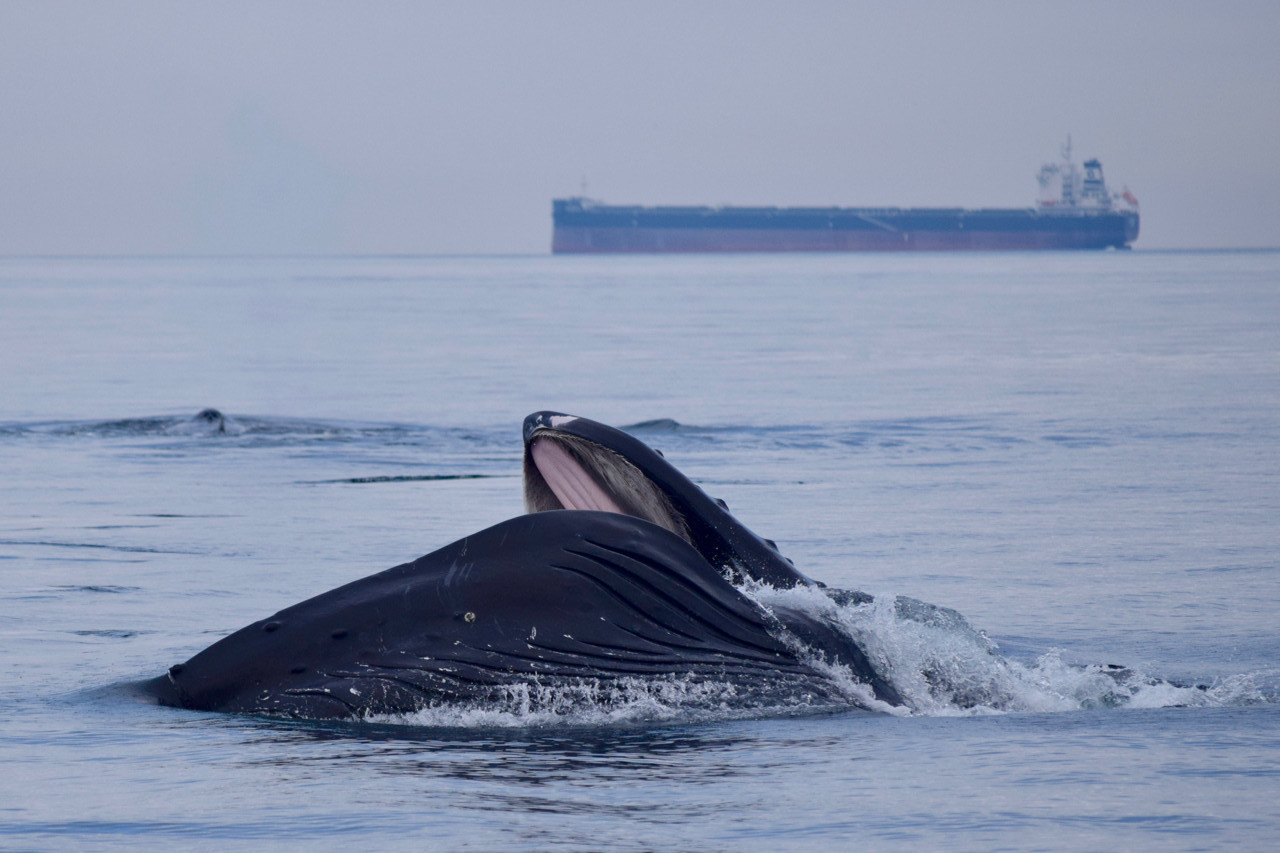Whales can be classified by whether they have teeth or baleen. This determines how and what they will munch on…
Baleen Whales
Baleen whales have baleen instead of teeth and include, right whales, gray whales, rorquals, and others. Baleen is made out of keratin (just like your fingernails) and makes up skinny, hard plates that hang down from the whale’s top jaw, the ends are frayed to help with filtering. There are small spaces between the plates, big enough to allow water to pass through but small enough to keep fish and plankton from escaping.

The location of whales in the ocean determines the type of prey that is available to eat. In addition, how they find their food can vary, too. For example, in some areas of the world humpback whales use bubble net feeding:
- A few whales called “The Herders” circle a school of fish into a ball
- A ring leader will blow bubbles from its blowhole in a spiraling circle starting low in the water column working their way up to the surface.
- The bubbles have now created a sort of tube-shaped net that the fish think they’re trapped in.
- In order for the fish to be corralled to the surface, another whale “The Caller” will stay at the base of the net and point a sound rocket of 180dbs into the water. In an attempt to escape from the noise, the panicked fish swim upwards.
- Finally the whales swim up very quickly from the bottom, open mouthed and eat the trapped fish!
For baleen whales, feeding efficiency increases with mouth size, which in turn increases with large body sizes. Huge baleen whales can swallow more calories per dive than their smaller cousins.
Why aren’t blue whales even bigger then?
Scientists think that it is probably due to seasonal shortages in krill density. Similarly, in the pacific northwest, herring is a favorite dish of our humpbacks that frequent these waters. However, upon returning to the warmer waters of Mexico and Hawaii very little fish are found and very little feeding occurs thus stunting their maximum growth.
Toothed Whales
Toothed whales have, well you guessed it, teeth! They include: killer whales, dolphins, porpoises, belugas, narwhals, beaked whales, and others. Toothed whales are some of the most widespread mammals, but some, as with the vaquita, are restricted to certain areas. Toothed Whales feed largely feed on fish and squid, but a few, like certain eco-types of killer whales, feed on marine mammals.
Echolocation is a prominent sense in toothed whales. It is a type of sonar that the animals rely on to help build up a picture of their surroundings.
- The whales create a sound deep within its skull that is amplified by a mass of fat on the top of their head called “The Melon”
- This echo travels out far into their surrounding environment hitting anything in its path.
- The echo returns and is received along the lower jaw of the animal. The signals regarding the location, size and kinds of foods available in their surroundings are transmitted to the inner ear to build up a 3D picture.

Killer whales, or, more lovingly named Orcas, usually hunt in family groups. Using teeth that can be four inches (ten centimeters) long.
In the water around Vancouver Island there are two distinct eco types…
Resident Orca
This ecotype loves to feed on Chinook Salmon as they are biggest and most energetically efficient prey but other species of salmon have also been found in their diet. Using echolocation to pinpoint a fish a whale will get as close as it can before launching its speedy attack.
This ecotype needs to eat between 100-300pounds of fish a day to stay healthy
Transient Orcas
Also known as mammal eating orca feed on anything from harbour seals to the calf’s of humpback and grey whales. About one harbour seal a day (each) is enough to keep these orca happy.
This group of orca is a silent eco type, not wanting to draw attention to themselves as their prey can hear them. As such, they hardly breach or call when on a hunt. The party comes after a successful feed!
The matriarchal orca in the group will be calling all the shots during a hunt- that’s right the females are in charge here! It can sometimes take up to an hour or even more to kill seals and whale calf’s.
Most seals and sea lions can hold their breath for longer than an orca and they’re very agile too which makes killing them a hard task. Drowning is always a good option but again this can take time. To quicken the process the prey will sometimes be shot in the air or hit with appendages to try and stun or even break its bones.
With whales calf’s another problem is added to the equation… a fully grown female. They’re fighters these mums and they wont let their child be taken without a fight so the orca have to deal with the mums as well as the other factors of drowning and the size of the calf.

It has been found that different groups of the same species will feed differently depending on their location, the season and what is available to them. For example, with the dwindling numbers of Chinook salmon our beloved Resident Orca may have to find a new favourite food as time moves on.
They will also have different hunting strategies too depending on their environment numbers and prey type.
Hunting strategies are passed on by learning and repeating. E.g. see an older animal do something that works do the same thing OR the same but develop it to be even better! This way feeding techniques are always improving and becoming more and more efficient- new strategies are being discovered all the time by scientist.
Lets eat!

